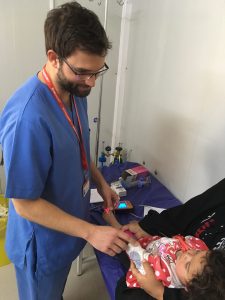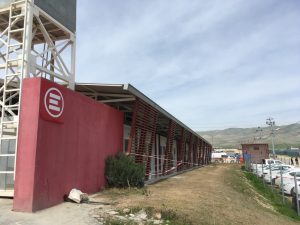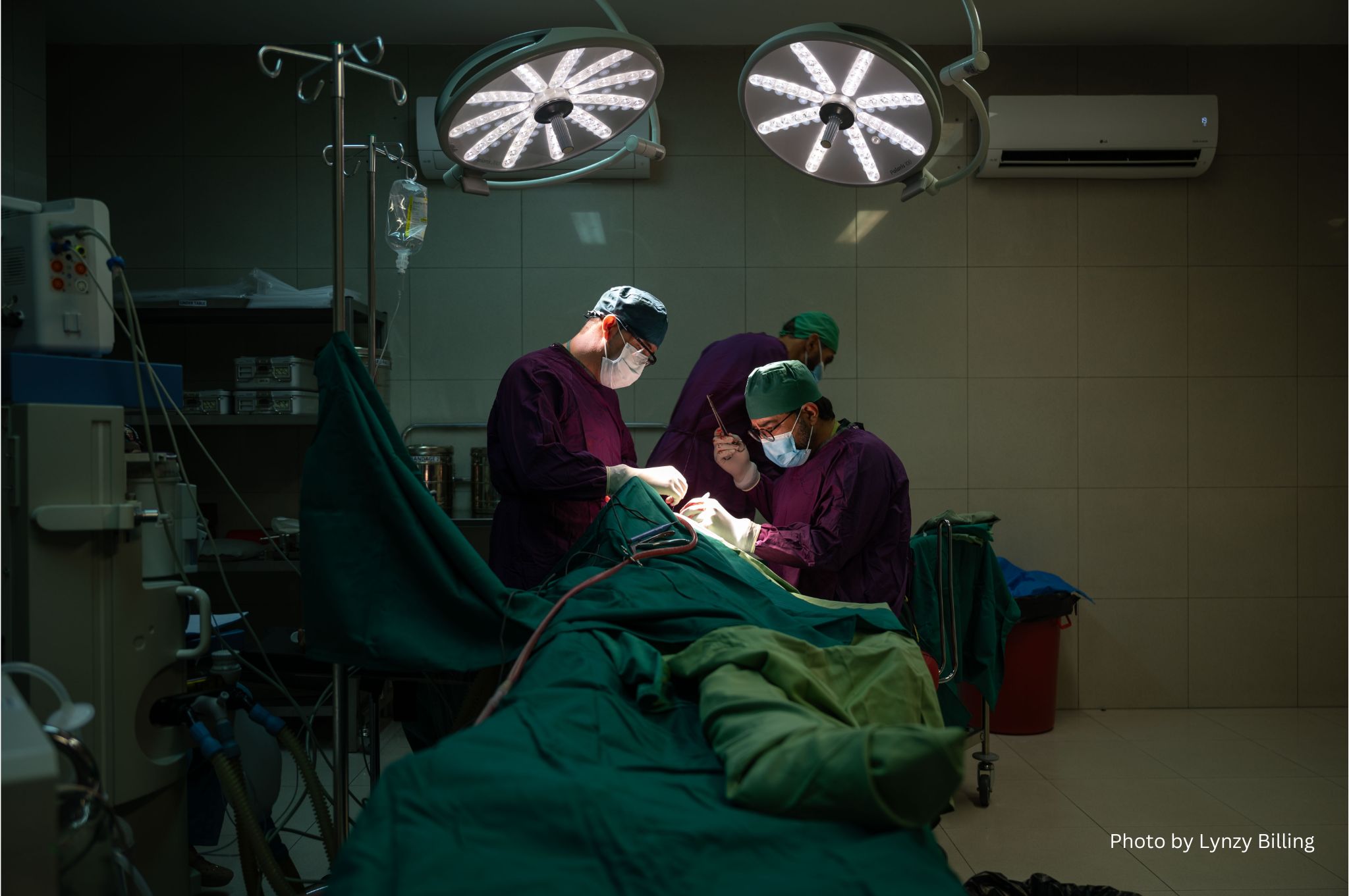In all of EMERGENCY's facilities around the world, we invest in women’s professional development -…

From London to Iraq: A Nurse’s Perspective – Part One
At EMERGENCY UK, one of our priorities is to encourage excellent medics based in the UK go into the field and work with us in our projects around the world. Mark is one of the the ever-growing number of UK-based medical staff who have taken the opportunity to provide high-quality healthcare in some of the world’s most challenging environments. Over the coming weeks and months, he will be sharing his experiences as a nurse in Iraqi Kurdistan, working with those affected by fighting in Iraq and Syria.

Hi! My name’s Mark and I’m a British nurse who normally works in an Emergency Department in central London. I am currently on my first mission with EMERGENCY in Iraqi Kurdistan. I previously volunteered in Greece with the Syrian American Medical Society, providing medical care to refugees who had made the crossing from Turkey to Europe. I chose to work with EMERGENCY because of the high standard of their work, their ethos of providing free care to all, and because it gave me the opportunity to work with Syrian refugees and Iraqi IDPs in Iraqi Kurdistan, a community of people I have come to know well through my previous missions. I hope that the following blogs and photos that will be posted on the EMERGENCY UK website can bring you closer to the work that we do every single day.
Settling in.
I flew into Eastern Turkey from Istanbul in the early afternoon. Meeting other EMERGENCY members there, we were collected and driven to the border with Iraq just a couple of hours away. The roads were heavily militarised with many reinforced police guard points along the way, a sign of the continued conflict between the Turkish military and PKK guerrillas in the region. The countryside was a verdant green, but extremely bare except for isolated villages and farmland.
At the border, we proceeded to wait for a couple of hours to get through. Groups of people milled around, several asking our driver for a lift across the border. We queued for a couple of hours as cars head of us passed through slowly. We had to pass through around four checkpoints in all, each one taking time to scrutinise our documents and ask our driver questions.

Finally across, we proceeded to a neighbouring town where we were met by EMERGENCY’s Kurdish staff. They took us for a good meal before we went to bed in a nearby hotel.
The next morning, we drove through the Kurdish region to Sulaymaniyah (Slemani) where EMERGENCY’s Centre for Rehabilitation and Social Reintegration is based. The route took us along the foothills of the mountains, through small towns and past beautiful countryside. ‘Suli’ (as its colloquially known) is the largest city in the Kurdish region, and the closest to the refugee and IDP camps where I will be working. International staff stay in a house near the centre of town. It is spacious, comfortable and clean, with food provided so that we can relax and rest when we are not working.
At the height of conflict in this region in the 80s and 90s, there were three landmines for every person living in the area.
EMERGENCY has been in Iraqi Kurdistan for over 20 years. Their first facilities here were started by Italian surgeon Gino Strada in 1996 in response to the need to provide healthcare and rehabilitation services for victims of landmines. At the height of conflict in this region in the 80s and 90s, there were three landmines for every person living in the area. Gino Strada has remained an outspoken critic of war and the military, and he, along with EMERGENCY, successfully led a campaign to have the Italian landmine factory which was producing the majority of these mines closed down in the late 90s.
EMERGENCY’s hospital in Erbil has since been handed over to the local Kurdish Ministry of Health (MOH) and it continues to provide healthcare to the surrounding population. But the organisation still runs the high-class rehabilitation facility in Sulaymaniyah, which integrates survivors back into the community through the provision of prosthetics, physiotherapy, training in a trade, and help finding work or starting their own business.
On the first day here, we had to go to immigration to get our Iraqi residency cards. After this, we headed to the Rehabilitation Centre for a tour. The centre is managed by Programme Manager Hawar and Medical Director Faris, who have been with EMERGENCY since the beginning. Our tour coincided with a visit from an Iraqi MOH official who was there to discuss collaboration between the centre and another rehabilitation centre in Mosul, which was damaged during the battle for the city. The fighting against ISIS in and around Mosul has left many civilians and soldiers amputees, and the MOH were invited to visit the centre to see the work they did and how they might collaborate better in treating victims of the war.
We visited the physiotherapy room where patients are taught to mobilise on their new prostheses. “We hate crutches”, remarked Hawar.
 We visited the physiotherapy room where patients are taught to mobilise on their new prostheses. “We hate crutches”, remarked Hawar. The aim for all the patients is that they are effectively no longer disabled by their injuries by the end of their stay in the centre, and able to be walking and living independently with minimal assistance. All the prostheses are manufactured in the rehab centre by the experienced staff here. Adjustments and changes are made pretty much on the spot to ensure a good fit, and the physiotherapists get the patients walking again in a number of weeks.
We visited the physiotherapy room where patients are taught to mobilise on their new prostheses. “We hate crutches”, remarked Hawar. The aim for all the patients is that they are effectively no longer disabled by their injuries by the end of their stay in the centre, and able to be walking and living independently with minimal assistance. All the prostheses are manufactured in the rehab centre by the experienced staff here. Adjustments and changes are made pretty much on the spot to ensure a good fit, and the physiotherapists get the patients walking again in a number of weeks.
We toured the workshops where the prostheses are manufactured. Due to the embargo on Iraq in the 90s, they were unable to access specialist equipment and materials, so they had to improvise. The centre had developed a high-quality prosthesis which they could make entirely from local materials, and which was of good quality. Now the embargo is over, they source specialist foot attachments from factories in Germany, but they still kept the old stock and moulds they used to make everything from the embargo days. Many of the patients even prefer their old model protheses because they are made of plastic and are lighter than some of the modern metal ones.
Some of the workshop equipment was also similarly improvised. Due to the inability to source high quality engineering equipment, they had to manufacture their own and had turned water pumps into lathes to shape the prostheses with. Built in the 90s, the lathes were still in use to this day, although they now have more high-tech equipment they can use for specialist materials if they need to.
After patients complete physiotherapy and are mobile again, they begin training in a variety of trades; tailoring, leathermaking, iron smelting, carpentry or PVC manufacture. Patients from outside Suli stay in a guesthouse in the centre, living and training together. There is a shared canteen where all the patients, local and international staff eat together, and they try to make the atmosphere as communal as possible.
Patients train for five months in the centre, learning a trade which can get them work. They receive a certificate at the end of the training, and the centre helps find them a job or to start their own business. Several of the trainers are themselves previous graduates from the centre, and its part of the patients’ recovery that they learn a trade and see fellow disabled people working and living successfully.
After the tour, we sat in Hawar’s office with the MOH official and discussed the situation regarding refugees and IDPs in the camps. EMERGENCY had been providing clinics in both a Syrian refugee camp, and an Iraqi IDP camp. They have now coordinated with local authorities to close or hand over some clinics, and are now running facilities in the IDP camp. These may also be handed over to the local MOH in the coming year. However, this depends on the plan for the camps and how long they will be here for. At present, the authorities are encouraging IDPs to return to their ‘places of origin’.
This is not easy, and impossible for many. Many families have had their homes completely destroyed by fighting, or the infrastructure in their town or village is so badly damaged they cannot live there anymore. Tensions between communities remain high, and various militias still operate across the country. Many simply don’t return out of fear. The Yazidi people in the camp likewise do not feel safe returning to their areas, although they are more scared of the resurgence of ISIS and several have said they no longer feel safe anywhere in Iraq and instead would prefer to head to Europe. For these and many other reasons, a lot of the people are staying put in the camps, and many who have attempted to return to their ‘place of origin’ are coming back to the camp, as conditions are in fact better there.
Conditions in the camp that EMERGENCY works in are decent if basic. Every family receives a tent for every seven family members, and each tent has an attached cooking area with running water and electricity. Tents are grouped in blocks of four and there are communal latrines for each block to share. In all, there are approximately 11,500 people in the camp, down from a high point of 17,000. Of these, 6,000 are below 14 years of age. There are four schools in the camp to accommodate all the young people needing schooling. UNICEF and several other NGOs have a presence in the camp, although they have recently been scaling back their work in response to the camp population decreasing, as some residents do try and make their way home.
The camp is called Ashti, Kurdish for ‘peace’, and our clinics are called Ashti 1 and Ashti 2. In the next update, I’ll write about the work that we do here.
This is the first instalment in Mark’s blog series. To see the next entry, click here.





